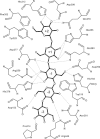Substrate recognition mechanism of a glycosyltrehalose trehalohydrolase from Sulfolobus solfataricus KM1
- PMID: 22334583
- PMCID: PMC3375754
- DOI: 10.1002/pro.2039
Substrate recognition mechanism of a glycosyltrehalose trehalohydrolase from Sulfolobus solfataricus KM1
Abstract
Glycosyltrehalose trehalohydrolase (GTHase) is an α-amylase that cleaves the α-1,4 bond adjacent to the α-1,1 bond of maltooligosyltrehalose to release trehalose. To investigate the catalytic and substrate recognition mechanisms of GTHase, two residues, Asp252 (nucleophile) and Glu283 (general acid/base), located at the catalytic site of GTHase were mutated (Asp252→Ser (D252S), Glu (D252E) and Glu283→Gln (E283Q)), and the activity and structure of the enzyme were investigated. The E283Q, D252E, and D252S mutants showed only 0.04, 0.03, and 0.6% of enzymatic activity against the wild-type, respectively. The crystal structure of the E283Q mutant GTHase in complex with the substrate, maltotriosyltrehalose (G3-Tre), was determined to 2.6-Å resolution. The structure with G3-Tre indicated that GTHase has at least five substrate binding subsites and that Glu283 is the catalytic acid, and Asp252 is the nucleophile that attacks the C1 carbon in the glycosidic linkage of G3-Tre. The complex structure also revealed a scheme for substrate recognition by GTHase. Substrate recognition involves two unique interactions: stacking of Tyr325 with the terminal glucose ring of the trehalose moiety and perpendicularly placement of Trp215 to the pyranose rings at the subsites -1 and +1 glucose.
Copyright © 2012 The Protein Society.
Figures







References
-
- de-Araujo PS. The role of trehalose in cell stress. Braz J Med Biol Res. 1996;29:873–875. - PubMed
-
- Newman YM, Ring SG, Colaco C. The role of trehalose and other carbohydrates in biopreservation. Biotechnol Genet Eng Rev. 1993;11:263–294. - PubMed
-
- Nakada T, Maruta K, Tsusaki K, Kubota M, Chaen H, Sugimoto T, Kurimoto M, Tsujisaka Y. Purification and properties of a novel enzyme, maltooligosyl trehalose synthase, from Arthrobacter sp. Q36. Biosci Biotechnol Biochem. 1995;59:2210–2214. - PubMed
-
- Nakada T, Maruta K, Mitsuzumi H, Kubota M, Chaen H, Sugimoto T, Kurimoto M, Tsujisaka Y. Purification and properties of a novel enzyme, maltooligosyl trehalose trehalohydrolase, from Arthrobacter sp. Q36. Biosci Biotechnol Biochem. 1995;59:2215–2218. - PubMed
Publication types
MeSH terms
Substances
LinkOut - more resources
Full Text Sources

